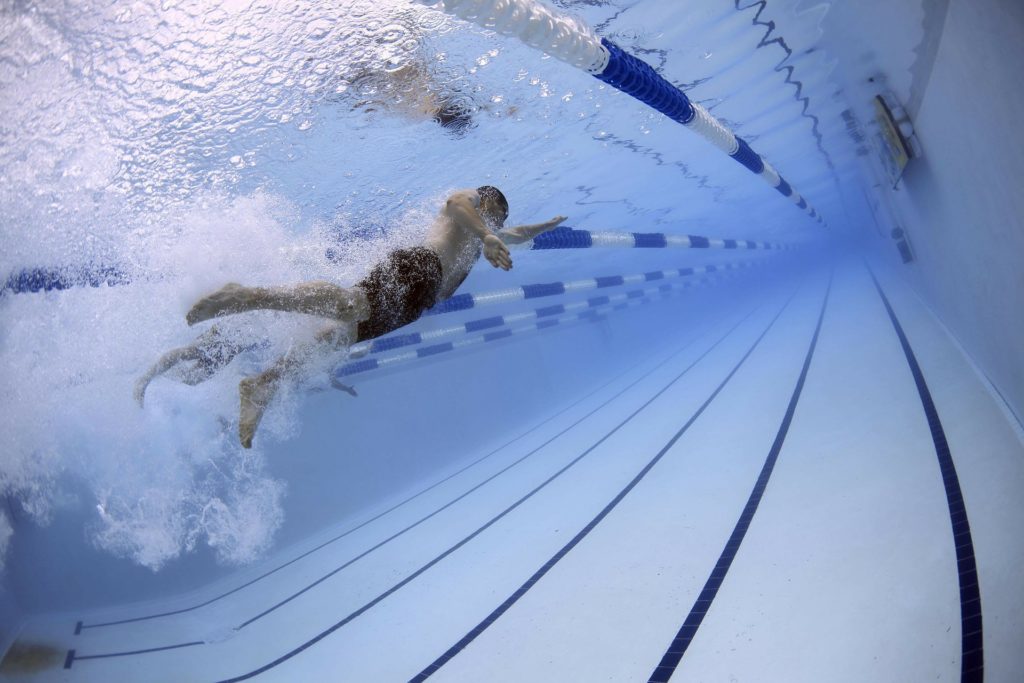Flips Turns for Triathletes? Pros and Cons

You’ve got yourself a pool membership or guest pass and are headed to start workouts for your first triathlon. Great! You push open the door from the locker room and see the typical pool crowd – aqua joggers, group lessons, and lap swimmers; it hits you, “OH!” I thought that I’d jump in and look like Michael Phelps. Maybe some speed and wait, do I need to do flip turns?
The biggest difference between open water swimming, where most triathlons take place, and pool swimming, is the walls that enclose the pool. At the start of a triathlon or open water swimming race, you either enter the water with a running start, a jump, or a dive, and are structurally on your own (with kayakers for support) until you return to the water’s edge. With the pool, after only a short period of swimming, you’ve reached the wall. Now what? Do you attempt a flip turn?
As a triathlete with 16 years’ swimming experience and over a decade of swim lessons under my belt, I can’t say that the answer is a hard yes or no. Check out the pros and cons to learning flip turns below so you can make the most informed decision for yourself!
Flips Turns for Triathletes – Pros and Cons
PRO: Flip Turns Make Pool Training More Efficient
By being able to flip turn at the wall, workouts can be more smooth and transitioning from one lap to the next becomes effortless. Touch turns are sufficient for beginners but create a greater need for the push off the wall to have enough momentum to keep up your pace, which translates well into open water swimming as you’ll need to maintain your pace throughout the distance without walls- being able to get that muscle memory of keeping up a kick, will have massive returns on race day.
CON: Flip Turns Take A Ton Of Time, Energy, And Effort To Learn That Could Be Spent On Other Skills
Putting together proper and efficient swim technique takes a lot of work! From building breathing patterns to body positioning to the kick and pull, there’s more mechanisms at work in the swim due to the full-body nature of the discipline. If you feel like your weakness is in bilateral breathing or something major enough that you know it needs to be the main focus of your workouts and stroke development, then this is not the time to work on flip turns.
PRO: Flip Turns Allow An Easier Transition Into Masters Swimming
If you find that you enjoy the camaraderie at your local pool or your triathlon friends have all joined the same Master’s team over the winter, learning to flip turn is an excellent way to be able to transition to more swim-intensive workouts with groups. One of the benefits of a Master’s team and practicing with them is that you’ll be assigned a lane with other swimmers around your pace, so you won’t have to worry about being lapped or passing people too much, but if you have your sights set on moving up to the next fastest lane, flip turns are a must!
CON: Unless At A Pool Triathlon, You Will Never Use Flip Turns In A Race
This is the biggest con in my personal opinion. If you are completing a triathlon as a bucket list item, find you’d prefer to stick to duathlons, or you have access to open water year round, there isn’t really a true need to learn to do a flip turn. Open water swimming and pool swimming can be very different, so if you find yourself gravitating away from the pool, I would recommend taking the time instead to practice sighting or temperature acclimation. The only resource that you don’t get back is time, so if in your overall athletic “big picture” the pool has little to no significance, skip the flip turns.
PRO: Flip Turns Can Help Build Endurance And Confidence
New swimmers can often end up in the “swim a lap and stop” method of training. While getting to the wall and increasing lap count is an excellent way to build strength and confidence in a measurable way, flip turns can be a great tool to keep you going with less breaks in between, ultimately helping new swimmers reach their target distance for race day.
One note I want to make about this article is that your swimming journey is ever-evolving, and these pros and cons may switch in priority for you over time. For example, in 2022 you may have no interest in joining a Master’s swim team, but in 2023 you may be enjoying your time in the pool enough that it’s something to look into. That’s what’s so fun about endurance sports, there’s so many possibilities! Take them into account and most importantly do what makes YOU happy!

Danielle Moore is a swimmer and triathlete living outside Philadelphia, Pennsylvania. Her athletic journey picked up at 10 years old when she started swimming in the summers, and ended up as a butterflyer for both her high school and college teams. She ran track in middle and high school as well, but swimming is her true passion in sports. Danielle has also been teaching swim lessons since 2010 and received her US Masters Swimming Level 1 Coach certification in March 2022. She raced her first sprint triathlon in 2019 and has been hooked ever since- she will be racing her first half Ironman in September 2022.









